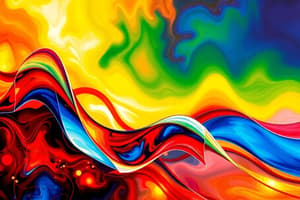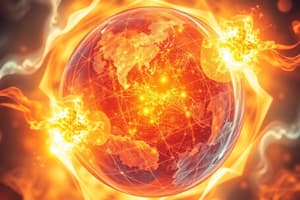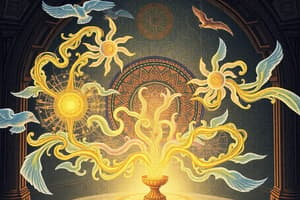Podcast
Questions and Answers
What are the two types of systems in thermodynamics?
What are the two types of systems in thermodynamics?
- Isolated and Closed
- Isolated and Open
- Closed and Open
- System and Surroundings (correct)
What is the primary function of chlorophyll in plants?
What is the primary function of chlorophyll in plants?
Chlorophyll absorbs light energy for photosynthesis.
What is the difference between exergonic and endergonic reactions?
What is the difference between exergonic and endergonic reactions?
Exergonic reactions release energy, while endergonic reactions require energy to proceed.
The first law of thermodynamics states that energy can be created or destroyed.
The first law of thermodynamics states that energy can be created or destroyed.
Entropy is a measure of disorder in a system.
Entropy is a measure of disorder in a system.
What is the process of photoexcitation?
What is the process of photoexcitation?
What are the two main types of photosystems in plants?
What are the two main types of photosystems in plants?
What is the role of the antenna complex in photosynthesis?
What is the role of the antenna complex in photosynthesis?
Flashcards
Forms of Energy
Forms of Energy
Different types of energy, like kinetic, thermal, light, potential, and chemical, that have the ability to do work.
Kinetic Energy
Kinetic Energy
Energy of motion.
Thermal Energy
Thermal Energy
Energy related to heat; the random movement of atoms.
Light Energy
Light Energy
Signup and view all the flashcards
Potential Energy
Potential Energy
Signup and view all the flashcards
Chemical Energy
Chemical Energy
Signup and view all the flashcards
Energy Flow in Ecosystems
Energy Flow in Ecosystems
Signup and view all the flashcards
First Law of Thermodynamics
First Law of Thermodynamics
Signup and view all the flashcards
Second Law of Thermodynamics
Second Law of Thermodynamics
Signup and view all the flashcards
Entropy
Entropy
Signup and view all the flashcards
Open System
Open System
Signup and view all the flashcards
Closed System
Closed System
Signup and view all the flashcards
Isolated System
Isolated System
Signup and view all the flashcards
ATP
ATP
Signup and view all the flashcards
Hydrolysis of ATP
Hydrolysis of ATP
Signup and view all the flashcards
ATP-ADP Cycle
ATP-ADP Cycle
Signup and view all the flashcards
GTP
GTP
Signup and view all the flashcards
Equilibrium
Equilibrium
Signup and view all the flashcards
Exergonic Reaction
Exergonic Reaction
Signup and view all the flashcards
Endergonic Reaction
Endergonic Reaction
Signup and view all the flashcards
Chemical Work
Chemical Work
Signup and view all the flashcards
Transport Work
Transport Work
Signup and view all the flashcards
Mechanical Work
Mechanical Work
Signup and view all the flashcards
Gibbs Free Energy
Gibbs Free Energy
Signup and view all the flashcards
Study Notes
Forms of Energy
- Energy flows into ecosystems as sunlight and leaves as heat, while essential chemical elements are recycled.
- Electromagnetic waves (sunlight) are the energy capacity to cause change in matter rearrangements.
- Energy exists in different forms in the environment.
- Heat can be converted from mechanical energy to electrical energy.
- Kinetic energy, thermal energy (heat), light energy, potential energy, and chemical energy are forms of energy.
- Thermodynamics studies energy transformations in systems (collections of matter).
- Living systems are open systems, exchanging energy and matter with surroundings.
- Systems include the system and surroundings; the universe includes both.
- There are different types of systems.
Laws of Energy Transformations
- Thermodynamics considers heat (therme) and transformations (dynamis).
- The first law of thermodynamics states that energy in the universe is constant; it can be transferred and transformed but not created or destroyed.
- The first law has two types of changes: transfer and transformation.
- Transfer includes conduction (solid-to-solid heat), convection (liquid-to-liquid heat), and radiation (gas).
- The second law of thermodynamics states that every energy transfer increases disorder (entropy), and living organisms are open systems with these energy transfers.
- Entropy describes energy unavailable for work; it increases in every transformation.
- An example is the food chain with varying energy transformation efficiency at each trophic level (production percentages).
ATP-ADP Cycle
- ATP (adenosine triphosphate) is the energy currency of cells.
- GTP is another energy form that powers cellular work.
- ATP has three phosphate groups, a ribose, and an adenine structure.
- ATP performs three types of cellular work (transport, mechanical, and chemical).
- ATP is regenerated by phosphorylation of ADP; ADP is two phosphates.
- Hydrolysis (using water to break bonds) releases energy from ATP to ADP
- This energy is used for cellular processes (chemical work, mechanical work, and transport work).
Photosynthesis
- Plant cells use chloroplasts, grana, thylakoids, and chlorophyll (alpha and beta) to capture sunlight's energy for photosynthesis.
- Carotenoids are pigments that absorb energy and provide color.
- Chlorophyll absorbs all colors of light accept green which is reflected.
- Carotenoids are light-absorbing pigments that assist in photosynthesis.
Photoexcitation
- Chlorophyll molecules absorb light energy and excite electrons (causing electrons transition levels) to higher energy levels.
- The excited electrons are transferred to other molecules, moving energy.
- This process occurs in photo systems.
Studying That Suits You
Use AI to generate personalized quizzes and flashcards to suit your learning preferences.




